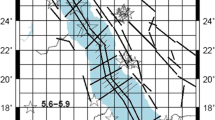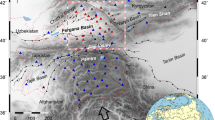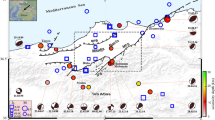Abstract
The historical seismicity of the last ten centuries and the instrumental data that occurred in the Gulf of Aqaba region during the period 1982–2008 are evaluated. It is found that 12 historical earthquakes have occurred with average recurrence periods 70–90 and 333–500 years for M ≥ 6.0 and 7.0, respectively. Those with M ≤ 6.5 appear to be incomplete and require further investigation. More than 98 % of the instrumental data has occurred in the form of swarms and sequences. The first have released about 32 % of the total energy and are most likely related to subsurface volcanic activities. Their epicentral distribution indicates that all regional faults of the gulf area are active in the present, but with clear concentration within the area bound by latitudes 28.2°–29.8° and longitudes 34.4°–35.2°. Regional strike-slip faults of the northern two basins appear to be as twice active as the normal, or more. An appreciable level of seismic hazard is envisaged as the “a” value is 6.0–6.2 while the “b” value shows a temporal variation, mostly in the range 0.8–1.05. More than 95 % of the seismic energy was released from earthquakes shallower than 22 km. This indicates a brittle upper crust and a ductile lower crust and upper mantle. Tectonic movements at depths > 22 km appear to be aseismic. The epicentral distribution of the five swarms indicates that the lengths of the causative faults varied in the range 45–70 km. The maximum expected magnitude is Mw = 6.8–7.2. This implies a seismic slip rate of about 0.54–0.8 Cm/year and some 20–30 % of aseismic tectonic movements. This and the sequence nature of the seismicity of this region result in a noticeable hazard reduction. Combining the seismicity data of the Gulf of Aqaba region with other geophysical, geological, tectonic, and environmental data, clearly indicate that the seismicity of this region is as old as the initiation of the gulf itself. No apparent southward or northward migration of activity is observed.






Similar content being viewed by others
References
Abdel-Fattah A, Hussein H, Ibrahim E, Abu El Atta A (1997) Fault plane solutions of the 1993 and 1995 Gulf of Aqaba earthquakes and their tectonic implications. Ann Geophys 40(6)
Abdel-Fattah A, Hussein H, El-Hady S (2006) Another look at the 1993 and 1995 Gulf of Aqaba earthquakes from the analysis of teleseismic waveforms. Acta Geophysica 54(3):260–279
Al-Amri M, Al-Amri A (1999) Configuration of the seismographic networks in Saudi Arabia. Seismol Res Lett 70(3):322
Alamri A, Schult F, Bufe C (1991) Seismicity and aeromagnetic features of the Gulf of Aqaba region. J Geophys Res 96(B12):20179–20
Ambraseys N, Melville C (1989) Evidence for intraplate earthquakes in northwest Arabia. Bull Seismol Soc Am 79(4):1279
Ambraseys N, C Melville, R Adams (1994) The seismicity of Egypt, Arabia, and the Red Sea: a historical review, Cambridge Univ Pr.
Badawy A, Horváth F (1999a) Seismicity of the Sinai subplate region: kinematicimplications. J Geodyn 27(4–5):451–468
Badawy A, Horváth F (1999b) The Sinai subplate and tectonic evolution of the northern Red Sea region. J Geodyn 27(4–5):433–450
Barberi F, Ferrara G, Santacroce R, Varet J (1975) Structural evolution of the Afar triple junction. Afar depression of Ethiopia 1:38–54
Bartov Y (1974) A structural and paleogeographical study of the central Sinai faults and domes. Unpublished Ph. D. thesis
Bayer H, Hotzl H, Jado A, Roscher B, Voggenreiter W (1988) Sedimentary and structural evolution of the northwest Arabian Red Sea margin. Tectonophysics 153(1–4):137–151
Bender F (1974) Geology of Jordan. Vol. 7, Balogh Scientific Books
Benioff H (1962) Movements on major transcurrent faults. Academic Press, London
Blank HR Jr (1977) Aeromagnetic and geologic study of Tertiary dikes and related structures on the Arabian margin of the Red Sea, S.A. Direct. General of Min. Resources Bulletin 22, p G1–G18
El-Isa ZH (1983) The Jordan University seismological station (UNJ). Proc. 1st Jord. Geol. Conf., 6–8 Sept. 1982, Jord Geologists Association, Amman, pp 542–564
El-Isa Z (1988) Seismic and seismological studies of the Jordan Dead Sea transform, Science Bull. Sanaa University 6:53–72
El-Isa Z (1990) Seismicity of the Jordan Dead Sea transform during the period 1981-1987, Proc. 4th Intern. Conf. Wegner/Medlas Project, Scheveningen, June 1989, Technical University, delft pp 47–66
El-Isa Z (1992) Seismicity of the Wadi Araba-Dead Sea Region. Geology of the Arab World: 245–253
El-Isa Z (2011) Temporal Variations in the b-value of the Earthquake Frequency-Magnitude-Distribution ( in preparation)
El-Isa Z, Shanti A (1989) Seismicity and tectonics of the Red Sea and western Arabia. Geophys J Int 97(3):449–457
El-Isa Z, Merghelani H, Bazzari M (1984) The Gulf of Aqaba earthquake swarm of 1983 January-April. Geophys J Roy Astron Soc 78(3):711–722
El-Isa Z, Mechie J, Prodehl C, Makris J, Rihm R (1987) A crustal structure study of Jordan derived from seismic refraction data. Tectonophysics 138(2–4):235–253
Ferry M, Meghraoui M, Abou Karaki N, Al-Taj M, Khalil L (2011) Episodic behavior of the Jordan Valley section of the Dead Sea fault inferred from a 14-ka-long integrated catalog of large earthquakes. Bull Seismol Soc Am 101(1):39
Fischer T, Horalek J, Hudova Z (2003) Source parameters and fault surface structure of the NW-Bohemia/Vogtland 2000-swarm. Paper presented at the meeting of the EGS-AGU-EUG Joint Assembly
Freund R, Garfunkel Z, Zak I, Goldberg M, Weissbrod T, Derin B, Bender F, Wellings F, Girdler R (1970) The Shear along the Dead Sea Rift [and Discussion]. Philos Trans R Soc Lond Ser A Math Phys Sci 267(1181):107
Garfunkel Z (1970) The tectonics of the western margins of the southern Arava: a contribution to the understanding of rifting. PhD diss., Hebrew University
Garfunkel Z (1981) Internal structure of the Dead Sea leaky transform (rift) in relation to plate kinematics. Tectonophysics 80(1–4):81–108
Garfunkel Z, Bartov J, Eyal Y, Steinitz G (1974) Raham Conglomerate-new evidence for Neogene tectonism in the southern part of the Dead Sea Rift. Geol Mag 111(1):55–64
Garfunkel Z, Zak I, Freund R (1981) Active faulting in the Dead Sea rift. Tectonophysics 80(1–4):1–26
Ginzburg A, Makris J, Fuchs K, Perathoner B, Prodehl C (1979) Detailed structure of the crust and upper mantle along the Jordan-Dead Sea rift. J Geophys Res 84(B10):5605–5612
Hill DP (1977) A Model for Earthquake Swarms. J Geophys Res 84(82):1347–1352
Horowitz A, Siedner G, Bar-Yosef O (1973) Radiometric dating of the Ubeidiya Formation, Jordan Valley, Israel. Nature (London) 250:23–26
Klinger Y, Rivera L, Haessler H, Maurin J (1999) Active faulting in the Gulf of Aqaba: New knowledge from the MW 7.3 earthquake of 22 November 1995. Bull Seismol Soc Am 89(4):1025
Klinger Y, Avouac J, Abou Karaki N, Dorbath L, Bourles D, Reyss J (2000) Slip rate on the Dead Sea transform fault in northern Araba valley (Jordan). Geophys J Int 142(3):755–768
Maamoon M, Megahed A and Allam A (1984) Seismicity of Egypt, HIAG, Vol. IV, Ser. B, 109–160
Marzouk IA (2008) Seismicity and seismotectonics of Egypt and surrounding region. NRIAG, Helwan
Mechie J, El-Isa Z (1988) Upper lithospheric deformations in the Jordan-Dead Sea transform regime. Tectonophysics 153(1–4):153–159
Meneisy M, Kreuzer H (1974) Potassium-argon ages of Egyptian basaltic rocks. Geol Jb 9:21–31
Mogi K (1968) Development of aftershock areas of great earthquakes. Bull Earthq Res Inst 46:175–203
Ogata Y, Utsu T, Katsura K (1995) Statistical features of foreshocks in comparison with other earthquake clusters. Geophys J Int 121:233–254, OUK
Pinar A, Turkelli N (1997) Source inversion of the 1993 and 1995 Gulf of Aqaba earthquakes. Tectonophysics 283(1–4):279–288
Poirier J, Taher M (1980) Historical seismicity in the near and Middle East, North Africa, and Spain from Arabic documents (VIIth-XVIIIth century). Bull Seismol Soc Am 70(6):2185
Quennell A (1959) Tectonics of the Dead Sea rift. Int. Geol. Congr., 20th Sess., Mexico 1956: 385–405
Said R (1962) The Geology of Egypt. Elsevier, Amsterdam, p 377
Salamon A, Hofstetter A, Garfunkel Z, Ron H (1996) Seismicity of the eastern Mediterranean region: Perspective from the Sinai subplate. Tectonophysics 263(1–4):293–305
Scholz C (2002) The mechanics of earthquakes and faulting, Cambridge Univ Pr.
Steckler M, Berthelot F, Lyberis N, Le Pichon X (1988) Subsidence in the Gulf of Suez: implications for rifting and plate kinematics. Tectonophysics 153(1–4):249–270
Steinitz G, Bartov Y, Hunziker J (1978) K-Ar age determinations of some Miocene-Pliocene basalts in Israel: their significance to the tectonics of the Rift Valley. Geol Mag 115(5):329–340
Utsu T (1971) Aftershocks and earthquake statistics (2): further investigation of aftershocks and other earthquake sequences based on a new classification of earthquake sequences. Journal of the Faculty of Science, Hokkaido University. Series 7, Geophysics 3 (4): 197–266
Zilberman E, Amit R, Porat N, Enzel Y, Avner U (2005) Surface ruptures induced by the devastating 1068 AD earthquake in the southern Arava valley, Dead Sea Rift, Israel. Tectonophysics 408(1–4):79–99
Acknowledgments
This work has been completed during a sabbatical year the author spent at the University of Michigan, Ann Arbor, with financial support from the University of Jordan, Amman. Thanks are due to Larry Ruff of UM for many useful discussions through the preparation of this work and his critical reading of the manuscript.
Author information
Authors and Affiliations
Corresponding author
Rights and permissions
About this article
Cite this article
El-Isa, Z.H. Seismicity and seismotectonics of the Gulf of Aqaba region. Arab J Geosci 6, 3437–3449 (2013). https://doi.org/10.1007/s12517-012-0604-8
Received:
Accepted:
Published:
Issue Date:
DOI: https://doi.org/10.1007/s12517-012-0604-8




